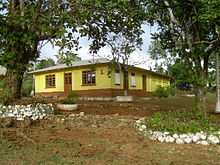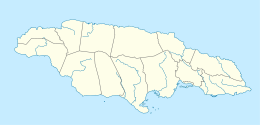Watsonville Primary School
| Watsonville Primary School | |
|---|---|
 | |
| Location | |
| River Head, St Ann Jamaica  Watsonville Primary School | |
| Coordinates | 18°16′15″N 77°05′27″W / 18.2709027°N 77.0907748°WCoordinates: 18°16′15″N 77°05′27″W / 18.2709027°N 77.0907748°W |
| Information | |
| School district | Brown's Town, Region 3 |
| School code | 06061 |
| Principal | Asrey James (2009 - current) |
| Staff | 3 |
| Grades | 1-6 |
| Enrolment | 62 |
| Language | English |
| Hours in school day | 08:30-15:00 (lunch 11:30-12:30) |
| Colour(s) | Brown, Yellow & White |
| Sports | Track & field, Cricket, Football and Netball |
| Team name | Reynolds, Manley & Glasspole |
| Alumni | Ben Hawthorne, Dr. Lynden Rose, Orville McGrath, Yvette Claire White, Mark Garvey |
Watsonville Primary School is located in River Head, near Moneague in St Ann, Jamaica. In the 2009-10 school year, 62 students, ages 6–11, were enrolled in grades 1 through 6 with a staff of 3 teachers.
History
The school, which is over 150 yrs old, was founded by the Methodist Church, which also owns the grounds and the nearby manse for the minister or overseeing steward. The school grounds also hosts a Principal’s cottage; a canteen; a water tank with run-off from the roof and a garden, which used to grow vegetables and crops to augment the supplies for the canteen. The school yard lacks a playground, causing the students to cross the street to play in an area donated by Reynolds Bauxite Company. The original section of the school was made from stone-nog, or chopped stones mixed with white lime and marl. There is also a Basic School for children 4-6 yrs on the compound.
Historic Buildings
- Head Master's Cottage -
The Head Master's Cottage was built at about the same time as the older part of the school. It originally had three rooms; another three rooms were added later. These six rooms were also made of stone-nog. In the 1960s the cottage was fitted with indoor plumbing and expanded, bringing the total number of rooms to eight.
- Methodist Church -
The history of Watsonville School is very closely linked to the history of Watsonville Methodist Church which is said to have been built by slave labor shortly after the Methodists arrived in Jamaica from England in 1789. The church was named Watsonville in honor of the Reverend Richard Watson (1781–1833), Methodist Minister and famous British abolitionist, who was a friend of the Methodist Mission in Jamaica. The edifice is made of cut stone, and the windows still contain some stained glass at the upper levels. It is thought that school was kept in the church during the 1800s until a school building was erected on the other side of the compound facing the church.
- Water Tank -
The tank was built in the 1940s, during Mr. Crawford's tenure as principal, and rises to a height of about eight feet instead of going deep into the ground. This appears to have been a special safety feature, designed by the contractor, to prevent students from climbing onto the structure. Water was supplied to the tank by gutters leading from the roof of the school. This was the only source of water for the school until the 1960s when it was connected to the public water system.
Principals
The following individuals served as principal during their various tenure:
| Name | Year |
|---|---|
| Mr. Benjamin H. Hawthorne | 1906-???? |
| Mr. Williams | 1926-???? |
| Mr. Crawford | 1940-???? |
| Mr. Walker | 1950–1953 |
| Mr. Lofters | 1953–1955 |
| Miss. Sally Sangster | 1955–1957 |
| Mr. Orphelio C. White | 1957–1970 |
| Mrs. Lola C. White | 1970–1982 |
| Mr. Randolph Williams | 1982–2009 |
| Mrs. Asrey James** | 2009-current |
WPSOSA
The alumni, Watsonville Primary School Old Students Association (WPSOSA) operates from Delaware, USA with members in the United States, Canada, UK and Jamaica.
The mission at Watsonville Primary School Old Students Association (WPSOSA) is to support the students of Watsonville Primary School in their pursuits of excellence through mentoring and by helping to create an enabling learning environment with current technologies and classroom resources which will empower them to optimize their full potential as scholars and to become socially responsible citizens.
References
External links
| ||||||||||||||||||||||||||